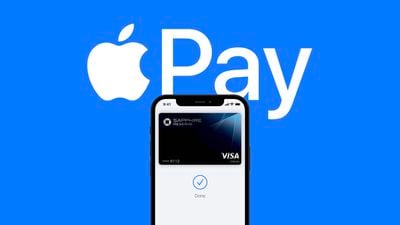Only six percent of iPhone users in the United States who have Apple Pay set up actually use the feature, according to a detailed study by PYMNTS.

Seven years after Apple Pay launched in September 2014, 93.9 percent of consumers with Apple Pay activated on their iPhone do not use it to pay for in-store purchases, meaning that only 6.1 percent do.
In 2015, the year following Apple Pay's launch, PYMNTS found that Apple Pay usage was just 5.1 percent among those that had the feature activated. This means that Apple Pay usage has only increased by one percentage point in six years.
The growth of Apple Pay in this time may be attributed to more contactless terminals in stores and more users having iPhone models with an NFC coil to facilitate Apple Pay, rather than increased usage. Since 2015, the total amount of Apple Pay transactions at U.S. retail stores has increased from an estimated $5 billion to $90 billion this year.
In 2015, 19 percent of U.S. merchants were able to accept contactless payments, but in 2021, this rose to 70 percent. Likewise, in 2015, only 36 percent of consumers had an iPhone that offered Apple Pay, but now 96 percent of users have access to the feature. Apple Pay support from banks has also ballooned. This has all led to the number of Apple Pay transactions growing overall, but it is still unused by the vast majority of those that have the feature enabled.
The main reason behind the lack of usage may be attributed to the continued dominance of plastic cards. In addition, in the time since Apple Pay's launch, banks have issued an increasing number of contactless debit and credit cards, which most users have preferred to Apple Pay. According to PYMNTS, Apple has struggled to persuade users that Apple Pay is valuable enough to replace the more familiar plastic card, which does not require additional button presses and authentication steps such as Touch ID or Face ID.
"But to be successful, innovation must solve a problem, fix a source of friction or improve an experience that is so painful that consumers or businesses are motivated to switch," the report explained. The study suggested two options for Apple to bolster Apple Pay usage:
Path one is for Apple, the smartphone, to take share from Android to make the eligible Apple Pay pie bigger and to ride retail's continued growth. Currently, Apple has a 52% share of smartphones in the U.S., up from 47% in 2019. That seems hard, if not pretty unlikely.
Path two is for Apple to get more iPhone users to use Apple Pay in the store.
That's something that Apple has failed to do over the last seven years – including over the last two years, when contactless payment in-store was its (and every Pay's) oyster.
Seven years in, Apple Pay just hasn't lived up to its potential for transforming the point-of-sale experience in the store. Maybe there is a grand plan that goes beyond offering users discounts to use it at checkout. But unless it does, its past is likely to be prologue – and its usage will likely be stuck at around 6% of iPhone users who like to wave their phones in the store when they buy.
Nevertheless, of the various mobile wallets, such as Samsung Pay, Google Pay, and PayPal, Apple Pay has generally been the most popular with a 45.5 percent share of mobile wallet users in 2021.
PYMNTS's findings are based on a study of 3,671 respondents in the United States between August 3 and August 10, 2021 and identical studies from previous years.























